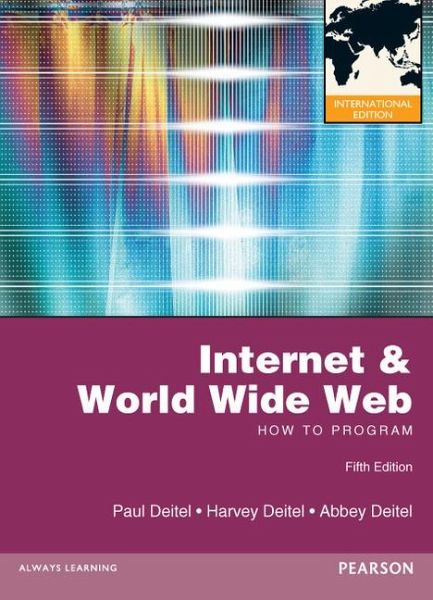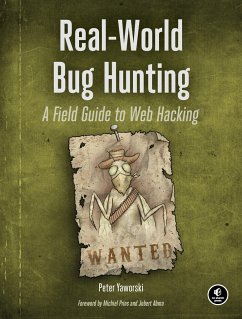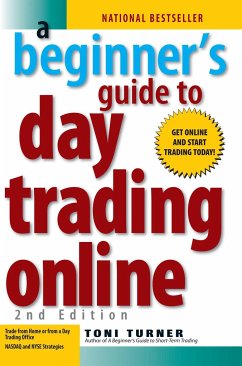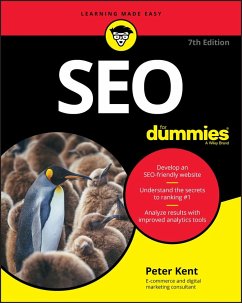
Internet & World Wide Web: How to Program
International Edition

PAYBACK Punkte
56 °P sammeln!
For a wide variety of Web Programming, XHTML, and JavaScript courses found in Computer Science, CIS, MIS, IT, Business, Engineering, and Continuing Education departments.
Internet and World Wide Web How to Program, 5e introduces students with little or no programming experience to the exciting world of Web-Based applications. The book has been substantially revised to reflect today's Web 2.0 rich Internet application-development methodologies. A comprehensive book that teaches the fundamentals needed to program on the Internet, this text provides in-depth coverage of introductory programming principles, various markup languages (XHTML, Dynamic HTML and XML), several scripting languages (JavaScript, PHP, Ruby/Ruby on Rails and Perl); AJAX, web services, Web Servers (IIS and Apache) and relational databases (MySQL/Apache Derby/Java DB)all the skills and tools needed to create dynamic Web-based applications. The text contains comprehensive introductions to ASP.NET and JavaServer Faces (JSF). Hundreds of live-code examples of real applications throughout the book available for download allow readers to run the applications and see and hear the outputs. The book provides instruction on building Ajax-enabled rich Internet applications that enhance the presentation of online content and give web applications the look and feel of desktop applications. The chapter on Web 2.0 and Internet business exposes readers to a wide range of other topics associated with Web 2.0 applications and businesses. After mastering the material in this book, students will be well prepared to build real-world, industrial strength, Web-based applications.
Features + Benefits
Full color — Program listings include highlighting of the new features presented and syntax coloring of code to help readers better interpret the code.
Signature “Live Code™ Approach” — Language features are presented in the context of complete working programs.
— Features thousands of lines of code in hundreds of complete working programs.
— Enables students to confirm that programs run as expected.
Outstanding, consistent and applied pedagogy:
— Icons throughout identify hundreds of Software Engineering Observations; Good Programming Practices; Common Programming Errors; Portability Tips; Performance Tips, Testing and Debugging Tips, and Look-and-Feel Observations.
— Provides hundreds of valuable programming tips and facilitates learning.
Extensive set of interesting exercises and substantial projects that enables students to apply what they've learned in each chapter.
Preface xix
Before You Begin xxxi
1 Introduction to Computers and the Internet 1
1.1 Introduction 2
1.2 The Internet in Industry and Research 3
1.3 HTML5, CSS3, JavaScript, Canvas and jQuery 6
1.4 Demos 9
1.5 Evolution of the Internet and World Wide Web 10
1.6 Web Basics 12
1.7 Multitier Application Architecture 16
1.8 Client-Side Scripting versus Server-Side Scripting 17
1.9 World Wide Web Consortium (W3C) 18
1.10 Web 2.0: Going Social 18
1.11 Data Hierarchy 23
1.12 Operating Systems 25
1.12.1 Desktop and Notebook Operating Systems 25
1.12.2 Mobile Operating Systems 26
1.13 Types of Programming Languages 27
1.14 Object Technology 29
1.15 Keeping Up-to-Date with Information Technologies 31
2 Introduction to HTML5: Part 1 37
2.1 Introduction 38
2.2 Editing HTML5 38
2.3 First HTML5 Example 38
2.4 W3C HTML5 Validation Service 41
2.5 Headings 41
2.6 Linking 42
2.7 Images 45
2.7.1 alt Attribute 47
2.7.2 Void Elements 47
2.7.3 Using Images as Hyperlinks 47
2.8 Special Characters and Horizontal Rules 49
2.9 Lists 51
2.10 Tables 54
2.11 Forms 58
2.12 Internal Linking 65
2.13 meta Elements 67
2.14 Web Resources 69
3 Introduction to HTML5: Part 2 76
3.1 Introduction 77
3.2 New HTML5 Form input Types 77
3.2.1 input Type color 80
3.2.2 input Type date 82
3.2.3 input Type datetime 82
3.2.4 input Type datetime-local 82
3.2.5 input Type email 83
3.2.6 input Type month 84
3.2.7 input Type number 84
3.2.8 input Type range 85
3.2.9 input Type search 85
3.2.10 input Type tel 86
3.2.11 input Type time 86
3.2.12 input Type url 87
3.2.13 input Type week 87
3.3 input and datalist Elements and autocomplete Attribute 87
3.3.1 input Element autocomplete Attribute 87
3.3.2 datalist Element 90
3.4 Page-Structure Elements 90
3.4.1 header Element 96
3.4.2 nav Element 96
3.4.3 figure Element and figcaption Element 96
3.4.4 article Element 96
3.4.5 summary Element and details Element 96
3.4.6 section Element 96
3.4.7 aside Element 96
3.4.8 meter Element 97
3.4.9 footer Element 98
3.4.10 Text-Level Semantics: mark Element and wbr Element 98
4 Introduction to Cascading Style Sheets™ (CSS): Part 1 105
4.1 Introduction 106
4.2 Inline Styles 106
4.3 Embedded Style Sheets 108
4.4 Conflicting Styles 111
4.5 Linking External Style Sheets 114
4.6 Positioning Elements: Absolute Positioning, z-index 116
4.7 Positioning Elements: Relative Positioning, span 118
4.8 Backgrounds 120
4.9 Element Dimensions 122
4.10 Box Model and Text Flow 123
4.11 Media Types and Media Queries 127
4.12 Drop-Down Menus 130
4.13 (Optional) User Style Sheets 132
4.14 Web Resources 136
5 Introduction to Cascading Style Sheets™
(CSS): Part 2 142
5.1 Introduction 143
5.2 Text Shadows 143
5.3 Rounded Corners 144
5.4 Color 145
5.5 Box Shadows 146
5.6 Linear Gradients; Introducing Vendor Prefixes 148
5.7 Radial Gradients 151
5.8 (Optional: WebKit Only) Text Stroke 153
5.9 Multiple Background Images 153
5.10 (Optional: WebKit Only) Reflections 155
5.11 Image Borders 156
5.12 Animation; Selectors 159
5.13 Transitions and Transformations 162
5.13.1 transition and transform Properties 162
5.13.2 Skew 164
5.13.3 Transitioning Between Images 165
5.14 Downloading Web Fonts and the @font-face Rule 166
5.15 Flexible Box Layout Module and :nth-child Selectors 168
5.16 Multicolumn Layout 171
5.17 Media Queries 173
5.18 Web Resources 177
6 JavaScript: Introduction to Scripting 185
6.1 Introduction 186
6.2 Your First Script: Displaying a Line of Text with JavaScript in a Web Page 186
6.3 Modifying Your First Script 189
6.4 Obtaining User Input with prompt Dialogs 192
6.4.1 Dynamic Welcome Page 192
6.4.2 Adding Integers 196
6.5 Memory Concepts 199
6.6 Arithmetic 200
6.7 Decision Making: Equality and Relational Operators 202
6.8 Web Resources 207
7 JavaScript: Control Statements I 214
7.1 Introduction 215
7.2 Algorithms 215
7.3 Pseudocode 215
7.4 Control Statements 215
7.5 if Selection Statement 218
7.6 if…else Selection Statement 219
7.7 while Repetition Statement 223
7.8 Formulating Algorithms: Counter-Controlled Repetition 225
7.9 Formulating Algorithms: Sentinel-Controlled Repetition 228
7.10 Formulating Algorithms: Nested Control Statements 234
7.11 Assignment Operators 238
7.12 Increment and Decrement Operators 239
7.13 Web Resources 242
8 JavaScript: Control Statements II 251
8.1 Introduction 252
8.2 Essentials of Counter-Controlled Repetition 252
8.3 for Repetition Statement 253
8.4 Examples Using the for Statement 256
8.5 switch Multiple-Selection Statement 261
8.6 do…while Repetition Statement 264
8.7 break and continue Statements 266
8.8 Logical Operators 268
8.9 Web Resources 271
9 JavaScript: Functions 278
9.1 Introduction 279
9.2 Program Modules in JavaScript 279
9.3 Function Definitions 280
9.3.1 Programmer-Defined Function square 281
9.3.2 Programmer-Defined Function maximum 283
9.4 Notes on Programmer-Defined Functions 285
9.5 Random Number Generation 286
9.5.1 Scaling and Shifting Random Numbers 286
9.5.2 Displaying Random Images 287
9.5.3 Rolling Dice Repeatedly and Displaying Statistics 291
9.6 Example: Game of Chance; Introducing the HTML5 audio and video Elements 296
9.7 Scope Rules 306
9.8 JavaScript Global Functions 308
9.9 Recursion 309
9.10 Recursion vs. Iteration 313
10 JavaScript: Arrays 324
10.1 Introduction 325
10.2 Arrays 325
10.3 Declaring and Allocating Arrays 327
10.4 Examples Using Arrays 327
10.4.1 Creating, Initializing and Growing Arrays 327
10.4.2 Initializing Arrays with Initializer Lists 331
10.4.3 Summing the Elements of an Array with for and for…in 332
10.4.4 Using the Elements of an Array as Counters 334
10.5 Random Image Generator Using Arrays 337
10.6 References and Reference Parameters 339
10.7 Passing Arrays to Functions 340
10.8 Sorting Arrays with Array Method sort 343
10.9 Searching Arrays with Array Method indexOf 344
10.10 Multidimensional Arrays 347
11 JavaScript: Objects 360
11.1 Introduction 361
11.2 Math Object 361
11.3 String Object 363
11.3.1 Fundamentals of Characters and Strings 363
11.3.2 Methods of the String Object 363
11.3.3 Character-Processing Methods 365
11.3.4 Searching Methods 366
11.3.5 Splitting Strings and Obtaining Substrings 369
11.4 Date Object 371
11.5 Boolean and Number Objects 376
11.6 document Object 377
11.7 Favorite Twitter Searches: HTML5 Web Storage 378
11.8 Using JSON to Represent Objects 385
12 Document Object Model (DOM): Objects and Collections 395
12.1 Introduction 396
12.2 Modeling a Document: DOM Nodes and Trees 396
12.3 Traversing and Modifying a DOM Tree 399
12.4 DOM Collections 409
12.5 Dynamic Styles 411
12.6 Using a Timer and Dynamic Styles to Create Animated Effects 413
13 JavaScript Event Handling: A Deeper Look 422
13.1 Introduction 423
13.2 Reviewing the load Event 423
13.3 Event mousemove and the event Object 425
13.4 Rollovers with mouseover and mouseout 429
13.5 Form Processing with focus and blur 433
13.6 More Form Processing with submit and reset 436
13.7 Event Bubbling 438
13.8 More Events 440
13.9 Web Resource 440
14 HTML5: Introduction to canvas 444
14.1 Introduction 445
14.2 canvas Coordinate System 445
14.3 Rectangles 446
14.4 Using Paths to Draw Lines 448
14.5 Drawing Arcs and C
Internet and World Wide Web How to Program, 5e introduces students with little or no programming experience to the exciting world of Web-Based applications. The book has been substantially revised to reflect today's Web 2.0 rich Internet application-development methodologies. A comprehensive book that teaches the fundamentals needed to program on the Internet, this text provides in-depth coverage of introductory programming principles, various markup languages (XHTML, Dynamic HTML and XML), several scripting languages (JavaScript, PHP, Ruby/Ruby on Rails and Perl); AJAX, web services, Web Servers (IIS and Apache) and relational databases (MySQL/Apache Derby/Java DB)all the skills and tools needed to create dynamic Web-based applications. The text contains comprehensive introductions to ASP.NET and JavaServer Faces (JSF). Hundreds of live-code examples of real applications throughout the book available for download allow readers to run the applications and see and hear the outputs. The book provides instruction on building Ajax-enabled rich Internet applications that enhance the presentation of online content and give web applications the look and feel of desktop applications. The chapter on Web 2.0 and Internet business exposes readers to a wide range of other topics associated with Web 2.0 applications and businesses. After mastering the material in this book, students will be well prepared to build real-world, industrial strength, Web-based applications.
Features + Benefits
Full color — Program listings include highlighting of the new features presented and syntax coloring of code to help readers better interpret the code.
Signature “Live Code™ Approach” — Language features are presented in the context of complete working programs.
— Features thousands of lines of code in hundreds of complete working programs.
— Enables students to confirm that programs run as expected.
Outstanding, consistent and applied pedagogy:
— Icons throughout identify hundreds of Software Engineering Observations; Good Programming Practices; Common Programming Errors; Portability Tips; Performance Tips, Testing and Debugging Tips, and Look-and-Feel Observations.
— Provides hundreds of valuable programming tips and facilitates learning.
Extensive set of interesting exercises and substantial projects that enables students to apply what they've learned in each chapter.
Preface xix
Before You Begin xxxi
1 Introduction to Computers and the Internet 1
1.1 Introduction 2
1.2 The Internet in Industry and Research 3
1.3 HTML5, CSS3, JavaScript, Canvas and jQuery 6
1.4 Demos 9
1.5 Evolution of the Internet and World Wide Web 10
1.6 Web Basics 12
1.7 Multitier Application Architecture 16
1.8 Client-Side Scripting versus Server-Side Scripting 17
1.9 World Wide Web Consortium (W3C) 18
1.10 Web 2.0: Going Social 18
1.11 Data Hierarchy 23
1.12 Operating Systems 25
1.12.1 Desktop and Notebook Operating Systems 25
1.12.2 Mobile Operating Systems 26
1.13 Types of Programming Languages 27
1.14 Object Technology 29
1.15 Keeping Up-to-Date with Information Technologies 31
2 Introduction to HTML5: Part 1 37
2.1 Introduction 38
2.2 Editing HTML5 38
2.3 First HTML5 Example 38
2.4 W3C HTML5 Validation Service 41
2.5 Headings 41
2.6 Linking 42
2.7 Images 45
2.7.1 alt Attribute 47
2.7.2 Void Elements 47
2.7.3 Using Images as Hyperlinks 47
2.8 Special Characters and Horizontal Rules 49
2.9 Lists 51
2.10 Tables 54
2.11 Forms 58
2.12 Internal Linking 65
2.13 meta Elements 67
2.14 Web Resources 69
3 Introduction to HTML5: Part 2 76
3.1 Introduction 77
3.2 New HTML5 Form input Types 77
3.2.1 input Type color 80
3.2.2 input Type date 82
3.2.3 input Type datetime 82
3.2.4 input Type datetime-local 82
3.2.5 input Type email 83
3.2.6 input Type month 84
3.2.7 input Type number 84
3.2.8 input Type range 85
3.2.9 input Type search 85
3.2.10 input Type tel 86
3.2.11 input Type time 86
3.2.12 input Type url 87
3.2.13 input Type week 87
3.3 input and datalist Elements and autocomplete Attribute 87
3.3.1 input Element autocomplete Attribute 87
3.3.2 datalist Element 90
3.4 Page-Structure Elements 90
3.4.1 header Element 96
3.4.2 nav Element 96
3.4.3 figure Element and figcaption Element 96
3.4.4 article Element 96
3.4.5 summary Element and details Element 96
3.4.6 section Element 96
3.4.7 aside Element 96
3.4.8 meter Element 97
3.4.9 footer Element 98
3.4.10 Text-Level Semantics: mark Element and wbr Element 98
4 Introduction to Cascading Style Sheets™ (CSS): Part 1 105
4.1 Introduction 106
4.2 Inline Styles 106
4.3 Embedded Style Sheets 108
4.4 Conflicting Styles 111
4.5 Linking External Style Sheets 114
4.6 Positioning Elements: Absolute Positioning, z-index 116
4.7 Positioning Elements: Relative Positioning, span 118
4.8 Backgrounds 120
4.9 Element Dimensions 122
4.10 Box Model and Text Flow 123
4.11 Media Types and Media Queries 127
4.12 Drop-Down Menus 130
4.13 (Optional) User Style Sheets 132
4.14 Web Resources 136
5 Introduction to Cascading Style Sheets™
(CSS): Part 2 142
5.1 Introduction 143
5.2 Text Shadows 143
5.3 Rounded Corners 144
5.4 Color 145
5.5 Box Shadows 146
5.6 Linear Gradients; Introducing Vendor Prefixes 148
5.7 Radial Gradients 151
5.8 (Optional: WebKit Only) Text Stroke 153
5.9 Multiple Background Images 153
5.10 (Optional: WebKit Only) Reflections 155
5.11 Image Borders 156
5.12 Animation; Selectors 159
5.13 Transitions and Transformations 162
5.13.1 transition and transform Properties 162
5.13.2 Skew 164
5.13.3 Transitioning Between Images 165
5.14 Downloading Web Fonts and the @font-face Rule 166
5.15 Flexible Box Layout Module and :nth-child Selectors 168
5.16 Multicolumn Layout 171
5.17 Media Queries 173
5.18 Web Resources 177
6 JavaScript: Introduction to Scripting 185
6.1 Introduction 186
6.2 Your First Script: Displaying a Line of Text with JavaScript in a Web Page 186
6.3 Modifying Your First Script 189
6.4 Obtaining User Input with prompt Dialogs 192
6.4.1 Dynamic Welcome Page 192
6.4.2 Adding Integers 196
6.5 Memory Concepts 199
6.6 Arithmetic 200
6.7 Decision Making: Equality and Relational Operators 202
6.8 Web Resources 207
7 JavaScript: Control Statements I 214
7.1 Introduction 215
7.2 Algorithms 215
7.3 Pseudocode 215
7.4 Control Statements 215
7.5 if Selection Statement 218
7.6 if…else Selection Statement 219
7.7 while Repetition Statement 223
7.8 Formulating Algorithms: Counter-Controlled Repetition 225
7.9 Formulating Algorithms: Sentinel-Controlled Repetition 228
7.10 Formulating Algorithms: Nested Control Statements 234
7.11 Assignment Operators 238
7.12 Increment and Decrement Operators 239
7.13 Web Resources 242
8 JavaScript: Control Statements II 251
8.1 Introduction 252
8.2 Essentials of Counter-Controlled Repetition 252
8.3 for Repetition Statement 253
8.4 Examples Using the for Statement 256
8.5 switch Multiple-Selection Statement 261
8.6 do…while Repetition Statement 264
8.7 break and continue Statements 266
8.8 Logical Operators 268
8.9 Web Resources 271
9 JavaScript: Functions 278
9.1 Introduction 279
9.2 Program Modules in JavaScript 279
9.3 Function Definitions 280
9.3.1 Programmer-Defined Function square 281
9.3.2 Programmer-Defined Function maximum 283
9.4 Notes on Programmer-Defined Functions 285
9.5 Random Number Generation 286
9.5.1 Scaling and Shifting Random Numbers 286
9.5.2 Displaying Random Images 287
9.5.3 Rolling Dice Repeatedly and Displaying Statistics 291
9.6 Example: Game of Chance; Introducing the HTML5 audio and video Elements 296
9.7 Scope Rules 306
9.8 JavaScript Global Functions 308
9.9 Recursion 309
9.10 Recursion vs. Iteration 313
10 JavaScript: Arrays 324
10.1 Introduction 325
10.2 Arrays 325
10.3 Declaring and Allocating Arrays 327
10.4 Examples Using Arrays 327
10.4.1 Creating, Initializing and Growing Arrays 327
10.4.2 Initializing Arrays with Initializer Lists 331
10.4.3 Summing the Elements of an Array with for and for…in 332
10.4.4 Using the Elements of an Array as Counters 334
10.5 Random Image Generator Using Arrays 337
10.6 References and Reference Parameters 339
10.7 Passing Arrays to Functions 340
10.8 Sorting Arrays with Array Method sort 343
10.9 Searching Arrays with Array Method indexOf 344
10.10 Multidimensional Arrays 347
11 JavaScript: Objects 360
11.1 Introduction 361
11.2 Math Object 361
11.3 String Object 363
11.3.1 Fundamentals of Characters and Strings 363
11.3.2 Methods of the String Object 363
11.3.3 Character-Processing Methods 365
11.3.4 Searching Methods 366
11.3.5 Splitting Strings and Obtaining Substrings 369
11.4 Date Object 371
11.5 Boolean and Number Objects 376
11.6 document Object 377
11.7 Favorite Twitter Searches: HTML5 Web Storage 378
11.8 Using JSON to Represent Objects 385
12 Document Object Model (DOM): Objects and Collections 395
12.1 Introduction 396
12.2 Modeling a Document: DOM Nodes and Trees 396
12.3 Traversing and Modifying a DOM Tree 399
12.4 DOM Collections 409
12.5 Dynamic Styles 411
12.6 Using a Timer and Dynamic Styles to Create Animated Effects 413
13 JavaScript Event Handling: A Deeper Look 422
13.1 Introduction 423
13.2 Reviewing the load Event 423
13.3 Event mousemove and the event Object 425
13.4 Rollovers with mouseover and mouseout 429
13.5 Form Processing with focus and blur 433
13.6 More Form Processing with submit and reset 436
13.7 Event Bubbling 438
13.8 More Events 440
13.9 Web Resource 440
14 HTML5: Introduction to canvas 444
14.1 Introduction 445
14.2 canvas Coordinate System 445
14.3 Rectangles 446
14.4 Using Paths to Draw Lines 448
14.5 Drawing Arcs and C
For a wide variety of Web Programming, XHTML, and JavaScript courses found in Computer Science, CIS, MIS, IT, Business, Engineering, and Continuing Education departments.
Internet and World Wide Web How to Program, 5e introduces students with little or no programming experience to the exciting world of Web-Based applications. The book has been substantially revised to reflect today's Web 2.0 rich Internet application-development methodologies. A comprehensive book that teaches the fundamentals needed to program on the Internet, this text provides in-depth coverage of introductory programming principles, various markup languages (XHTML, Dynamic HTML and XML), several scripting languages (JavaScript, PHP, Ruby/Ruby on Rails and Perl); AJAX, web services, Web Servers (IIS and Apache) and relational databases (MySQL/Apache Derby/Java DB)?all the skills and tools needed to create dynamic Web-based applications. The text contains comprehensive introductions to ASP.NET and JavaServer Faces (JSF). Hundreds of live-code examples of real applications throughout the book available for download allow readers to run the applications and see and hear the outputs. The book provides instruction on building Ajax-enabled rich Internet applications that enhance the presentation of online content and give web applications the look and feel of desktop applications. The chapter on Web 2.0 and Internet business exposes readers to a wide range of other topics associated with Web 2.0 applications and businesses. After mastering the material in this book, students will be well prepared to build real-world, industrial strength, Web-based applications.
Internet and World Wide Web How to Program, 5e introduces students with little or no programming experience to the exciting world of Web-Based applications. The book has been substantially revised to reflect today's Web 2.0 rich Internet application-development methodologies. A comprehensive book that teaches the fundamentals needed to program on the Internet, this text provides in-depth coverage of introductory programming principles, various markup languages (XHTML, Dynamic HTML and XML), several scripting languages (JavaScript, PHP, Ruby/Ruby on Rails and Perl); AJAX, web services, Web Servers (IIS and Apache) and relational databases (MySQL/Apache Derby/Java DB)?all the skills and tools needed to create dynamic Web-based applications. The text contains comprehensive introductions to ASP.NET and JavaServer Faces (JSF). Hundreds of live-code examples of real applications throughout the book available for download allow readers to run the applications and see and hear the outputs. The book provides instruction on building Ajax-enabled rich Internet applications that enhance the presentation of online content and give web applications the look and feel of desktop applications. The chapter on Web 2.0 and Internet business exposes readers to a wide range of other topics associated with Web 2.0 applications and businesses. After mastering the material in this book, students will be well prepared to build real-world, industrial strength, Web-based applications.
Dieser Artikel kann nur an eine deutsche Lieferadresse ausgeliefert werden.













